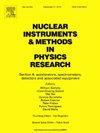Design of an atmospheric muon tomographer for material identification based on CORSIKA+ GEANT4 simulations
IF 1.4
3区 物理与天体物理
Q3 INSTRUMENTS & INSTRUMENTATION
Nuclear Instruments & Methods in Physics Research Section A-accelerators Spectrometers Detectors and Associated Equipment
Pub Date : 2025-07-23
DOI:10.1016/j.nima.2025.170819
引用次数: 0
Abstract
In recent years, muon tomography has appeared as a powerful and innovative technique for non-invasive imaging of both large and small structures, with applications in different fields such as geology, archeology and security. This study presents the design and simulation of a portable, easy-to-construct detector based on plastic scintillators and silicon photomultipliers using current technology. The cosmic ray flux reaching the Earth’s atmosphere was input to CORSIKA to simulate atmospheric muons and other secondary particles at ground level. The detector and the target object geometry and materials were simulated using GEANT4, transporting the previously generated muon flux. Two muon tomography methods, based on data on muon absorption or scattering, were employed to distinguish objects composed of different materials. Statistical differences were quantified for various object sizes and materials. Using a 3 threshold in the first method, it was determined that objects made of lead can be distinguished from those made of other materials. The observation times required to differentiate an object made of lead from one made of aluminum were days and days for the first and second methods, respectively.
基于CORSIKA+ GEANT4模拟的大气介子层析仪材料识别设计
近年来,介子层析成像作为一种强大的、创新的、可用于大型和小型结构的无创成像技术,在地质、考古和安全等不同领域得到了广泛的应用。本研究提出了一种基于塑料闪烁体和硅光电倍增管的便携式、易于构建的探测器的设计和仿真。到达地球大气层的宇宙射线通量被输入到CORSIKA中,以模拟大气中的μ子和其他地面上的次级粒子。利用GEANT4模拟探测器和目标物体的几何形状和材料,传递先前产生的μ子通量。基于介子吸收或散射数据,采用两种介子断层扫描方法来区分由不同材料组成的物体。对不同物体尺寸和材料的统计差异进行量化。在第一种方法中使用3 σ阈值,确定了铅制成的物体可以与其他材料制成的物体区分开来。第一种方法和第二种方法区分铅制物体和铝制物体所需的观察时间分别为1.3±0.2天和9.4±3.7天。
本文章由计算机程序翻译,如有差异,请以英文原文为准。
求助全文
约1分钟内获得全文
求助全文
来源期刊
CiteScore
3.20
自引率
21.40%
发文量
787
审稿时长
1 months
期刊介绍:
Section A of Nuclear Instruments and Methods in Physics Research publishes papers on design, manufacturing and performance of scientific instruments with an emphasis on large scale facilities. This includes the development of particle accelerators, ion sources, beam transport systems and target arrangements as well as the use of secondary phenomena such as synchrotron radiation and free electron lasers. It also includes all types of instrumentation for the detection and spectrometry of radiations from high energy processes and nuclear decays, as well as instrumentation for experiments at nuclear reactors. Specialized electronics for nuclear and other types of spectrometry as well as computerization of measurements and control systems in this area also find their place in the A section.
Theoretical as well as experimental papers are accepted.

 求助内容:
求助内容: 应助结果提醒方式:
应助结果提醒方式:


